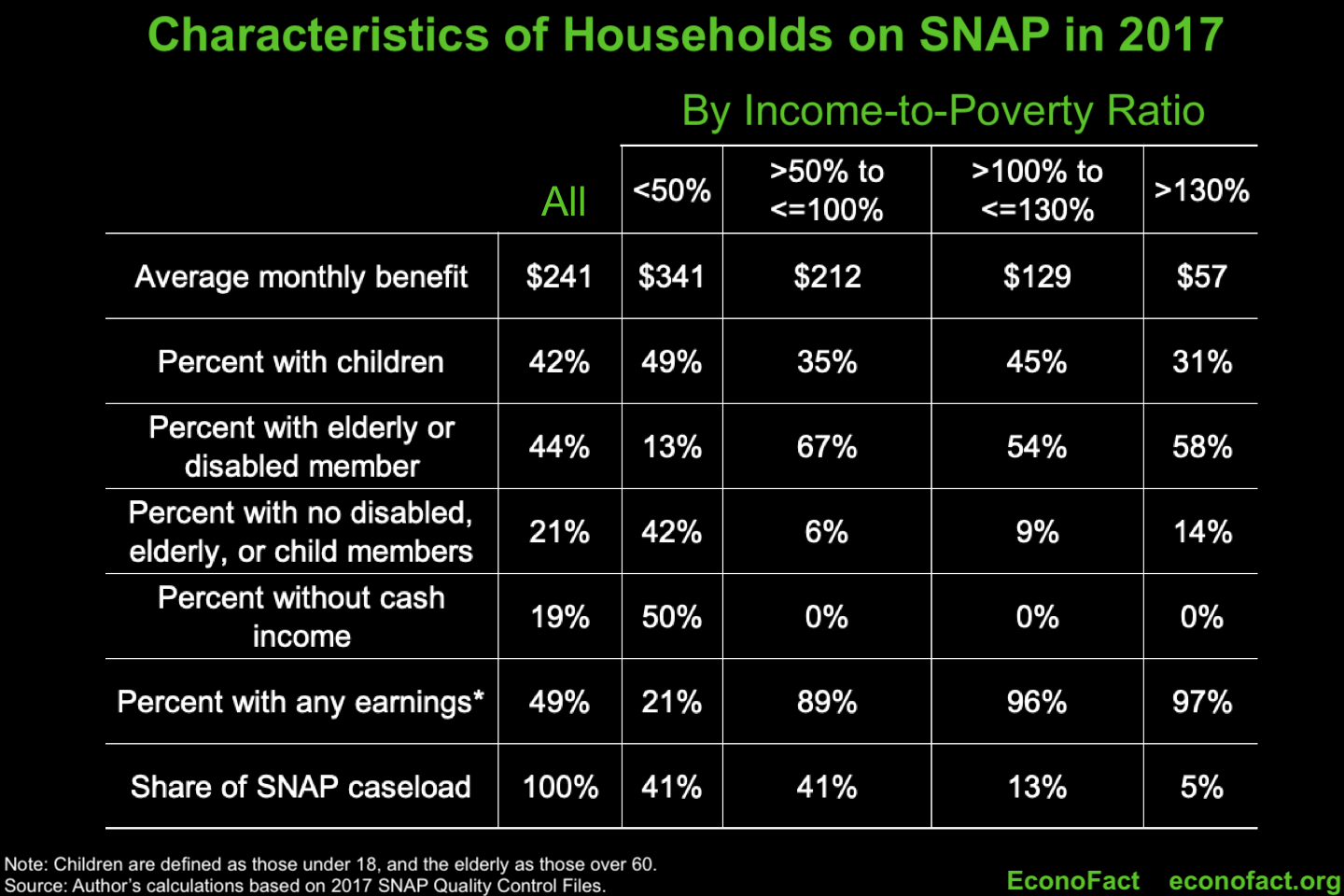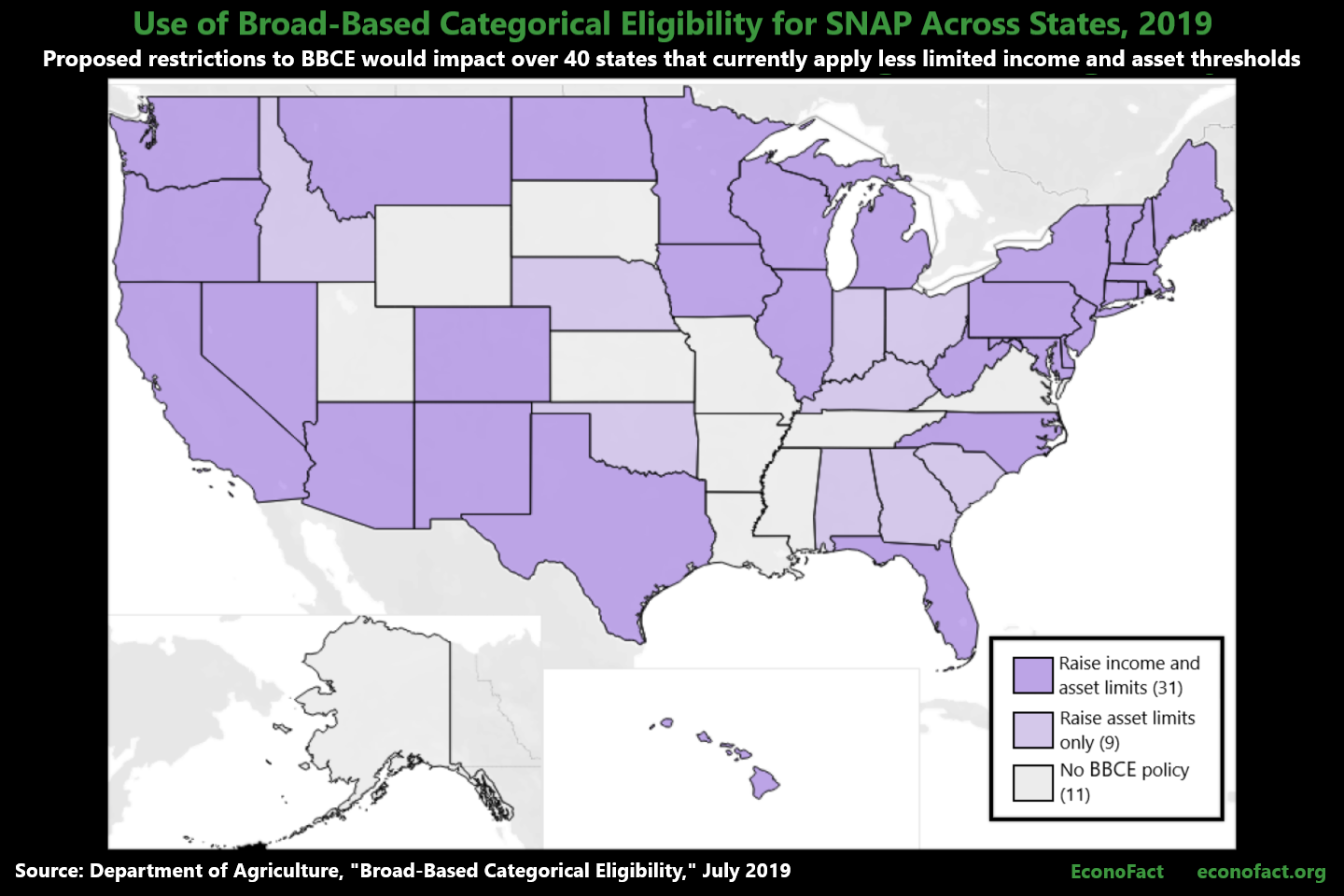Who Would Be Affected by Proposed Changes to SNAP?
School of Education & Social Policy and Institute for Policy Research, Northwestern University
The Issue:
The U.S. Department of Agriculture (USDA) proposed new rules for the Supplemental Nutrition Assistance Program (SNAP) that terminate SNAP eligibility for over 3 million people who currently qualify under Broad-Based Categorical Eligibility (BBCE). These are mostly working families, people with disabilities, and the elderly. The CBO estimates this change will reduce spending by $5.1 billion on SNAP and school meals over the next 5 years.
The proposed rule would likely raise administrative costs, increase food insecurity for some households and reduce spending in local economies.
The Facts:
- The Supplemental Nutrition Assistance Program (SNAP) provides benefits that help low-income families afford the food that they need. Formerly known as food stamps, SNAP benefits can be used to purchase most foods at qualified retailers. In 2018, 39.6 million people or a little over 1 in 10 Americans participated in SNAP, and $60.4 billion was spent on benefits. The average person received about $127 in benefits per month in 2018, or about $255 per household, on average (see here). As such, SNAP is one of the nation's largest anti-poverty programs — a 2019 consensus report by the National Academies of Sciences estimated that in the absence of SNAP the U.S. child poverty rate would have been 5 percentage points higher in 2015. There is consistent evidence that the program leads to short- and long-term benefits. Receiving this nutrition assistance is associated with greater food security, higher birth-weights and improved infant health, which can provide benefits that persist into adulthood (see here).
- Under federal rules, to be eligible for SNAP a household’s "net income" must be below the poverty line. Benefits are based on the family’s “net income” under the SNAP benefits formula, which is calculated as total (or “gross”) income minus a series of deductions, which reflect the fact that some fraction of a household's income must be used to meet needs other than food. These deductions include a standard deduction available to all households, a fraction of earned income, childcare expenses, legally obligated child support, housing costs that exceed half of the family’s net income, and medical expenses for elderly or disabled household members (see here).
- In addition to the "net income" test, federal rules call for two additional tests for SNAP eligibility: a "gross income test" and an "asset test". But states have had the option to loosen these rules under Broad-Based Categorical Eligibility (BBCE). States can deem some groups “categorically eligible” for SNAP, meaning that they do not separately have to pass SNAP’s gross income or asset tests. Some groups — such as those receiving cash welfare under AFDC or Supplemental Security Income (SSI) — have long been considered categorically eligible for SNAP. Since 1996, states have been able to deem households receiving non-cash benefits funded under the Temporary Assistance for Needy Families (TANF) block grant (which replaced AFDC) as categorically eligible, thus subjecting a larger share of families to higher cutoffs under the gross income or asset tests. In all cases, these households only receive SNAP benefits if they qualify for them under the benefits formula based on their net income and if they go through an application and interview process. Over 40 states use BBCE to raise the gross income or asset tests (see map). Note that states do not have the option of further restricting eligibility beyond the federal rules.
- If the proposed rule goes into effect, an important share of current SNAP recipients will be subject to the more stringent cutoffs of the "gross income test" and the "asset test". Under the “gross income” test, the family’s total monthly income must be no higher than 130 percent of the poverty line, unless there is an elderly or disabled member in the household. And, under the “asset test” certain of the family’s assets (which generally include bank accounts, but not retirement savings or most automobiles) must fall below $2250, or $3500 for households with an elderly or disabled member in order to qualify for SNAP benefits.
- Who is ineligible if the gross income test is set at 130% of poverty? In order to qualify for SNAP, recall that a family’s net income must be below the poverty line. Eliminating BBCE would make families with gross incomes above 130% of poverty ineligible for SNAP. The families who have higher gross incomes but still have low net incomes have high levels of deductions, due to earnings (20 percent of earned income can be deducted), or high costs of housing or childcare. Hence the families that are helped by the Broad-Based Categorical Eligibility tend to be those that have high expenses. One study calculates the following characteristics of benefits paid to households under BBCE: more than 90 percent go to households with utilities and rent or mortgage costs greater than half of their net incomes; half go to households with dependent care costs; three-quarters go to households with gross incomes between 131 and 150 percent of poverty. Families with gross incomes above 130 percent of the poverty threshold made up approximately 5 percent of households who received SNAP benefits in 2017 and received 1.2 percent of total SNAP payments, according to my calculations from SNAP program administrative data. They are disproportionately families that have earnings; have child, elderly, or disabled members; or both. They receive an average monthly benefit of $57 (see chart below).

- When the gross income test is binding, there is a sharp cliff in benefits that provides a financial disincentive against increasing a family’s income. In this scenario, a small increase in earnings leaves a family worse off because it leads them to lose SNAP benefits. Consider the example provided by Rosenbaum (2019): Imagine a single mother with two children, who works full time at $12.50 per hour and has typical monthly shelter costs of $1209. At this wage, her income is 125 percent of poverty and she is eligible for about $160 in monthly SNAP benefits. If she were to receive a $0.50 hourly wage increase, her earnings would increase by $86 per month, but she would have an income slightly above 130 percent of the poverty line. In the absence of BBCE, she would lose her SNAP benefits—leaving her family about $75 per month worse off. Under BBCE, her SNAP benefits would be reduced to partially offset her increased earnings but she would still receive about $130 per month in SNAP. On net, her family would be $55 per month better off due to the wage increase under BBCE, but $75 per month worse off if BBCE were eliminated.
- Who is ineligible under a stricter asset test? Some states have used BBCE to extend SNAP access to those with assets above the federal limit of $2,250 in countable assets for most households, or $3500 for households with an elderly or disabled member. Vehicles count toward the asset test to the extent that their resale value exceeds $4650. Many SNAP households have very few assets. Fewer than half have any liquid assets, and the median value among these is just $450. However, low-income households with assets above the test limit tend to have assets substantially above the limits, with median liquid asset levels of $36,000, and are more likely to include elderly members. The asset test reduces the population eligible for SNAP by 14 percent (see here).
- A low asset test means that households that participate in SNAP are unable to build savings without losing food assistance. Such savings could help them weather future financial emergencies, or allow them to invest in education or a reliable vehicle. It also means that families that experience a short-term financial crisis or job loss have to liquidate their savings before they can obtain assistance from SNAP. This can be especially problematic for households with elderly or disabled members who may have limited ability to save because they no longer work.
- Eliminating waivers to the asset test in SNAP would increase the administrative cost burden associated with collecting asset data, which would offset potential savings from reducing participation in SNAP. While few SNAP applicants have assets above the federal limits, in the absence of Broad-Based Categorical Eligibility caseworkers have to collect information about assets for all applicants. At a recent House Agriculture Committee Hearing, program directors from Mississippi and Wisconsin testified that elimination of BBCE would cost their states $1.5 to $2 million in additional administrative costs (see here).
- Eliminating BBCE would reduce free school meals. Children in households that participate in SNAP are directly certified for receiving free school meals without needing to complete additional paperwork. The CBO estimates that 265,000 children receive free school meals because of the BBCE provision. If BBCE is eliminated, many of these children still would be eligible for reduced-price school meals, but would have to separately apply for this subsidy.
- Eliminating BBCE would harm the local economy. SNAP benefits typically are quickly spent in the local economy, which means that SNAP has an important local fiscal multiplier impact. Reductions in SNAP benefits would be expected to result in less spending in local food retail outlets and other venues, as low-income families have fewer resources to spend.
What this Means:
Eliminating BBCE under SNAP would remove 3 million individuals from the program, largely working families with children, and households containing elderly and disabled members. We expect that their spending will decrease, and measures of hardship such as food insecurity will increase. This will impact the local economy. In addition, fewer children will participate in free or subsidized school meals programs. Eliminating BBCE would reduce total SNAP spending and target a higher share of it at the neediest families but, at the same time, it would harm many families that are working while receiving benefits. It would also increase administrative costs and add a sharp benefits cliff into the program and increase work disincentives.
Like what you’re reading? Subscribe to EconoFact Premium for exclusive additional content, and invitations to Q&A’s with leading economists.

